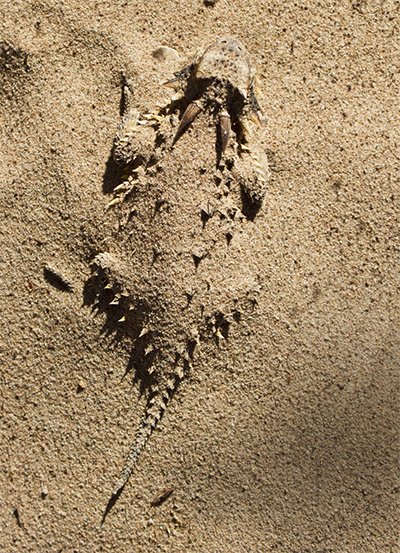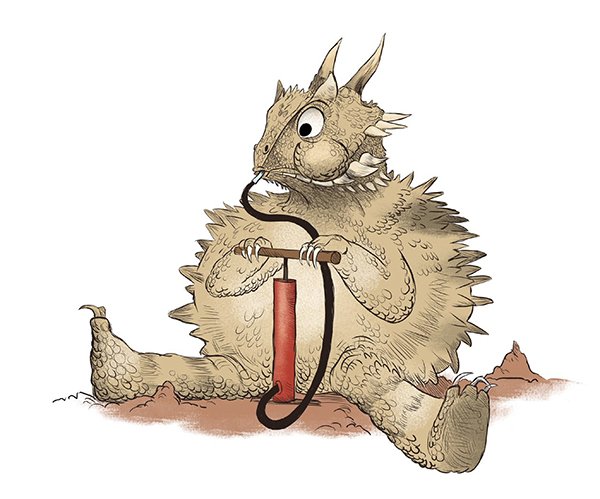
Decked Out for the Desert
Horned lizards aren’t known for speed to avoid predators or venom to bring down threats. But these miniature dragons have other tricks in their arsenal for desert survival.
“DAY 15. Ran out of water yesterday. Haven’t had a decent meal in a week. Nearly froze last night. Now I’m so hot I’m hallucinating. No shade. No place to hide. Don’t think I can last much longer . . .”
You’ll never see this in a horned lizard’s journal. These diminutive desert dragons may not be as menacing as man-eating crocodiles or venomous vipers, but they are better equipped than Navy SEALs to live life on the edge. Their edge is the dry, forbidding deserts of North and Central America.
Hotheads
Like all reptiles, horned lizards get their body heat from the environment. Either they soak in the sun’s rays directly, or they soak in the heat from the ground. This is a great advantage in the desert where food may be scarce—since they don’t have to produce their own heat, they can survive on fewer calories.
Night is a challenge. To avoid temperature extremes (and nighttime predators), horned lizards bury themselves in the sandy soil. But cold desert nights can still chill them to the bone. And a cold lizard is a slow lizard. If they had to haul themselves out of the sand each morning and wait for the sun to warm them, they’d be sitting ducks for any carnivore looking for an easy breakfast.
So God gave horned lizards a little trick to warm themselves quickly before they leave the sand. They poke only their heads out into the morning sun. This heats up their brains and a strategically placed blood sinus (cavity). Once the sinus has warmed sufficiently, the lizard dilates the blood vessels leading to the rest of its cold, buried body. In this way, it heats up while still hidden under the cool sand. Once it’s warm, the lizard can emerge, alert and agile, ready to face the day.
Eating Dinner Without Becoming Dinner

Photo by Danita Delimont
When horned lizards bury themselves in the sand, their spiky outline and desert coloring make them difficult to see while they wait for a meal to walk by.
With predators prowling the wide-open desert, horned lizards have a problem. They are ant-eating specialists (although they munch on other insects, too). This means they must park themselves next to a column of foraging ants and snap them up one by one with their sticky tongues. The problem is, most ants are small and contain a lot of indigestible bits, so horned lizards must eat prodigious quantities of them. While they sit around eating ants, they are a tempting target for predators.
To make matters worse, massive meals require a massive stomach. Horned lizards’ stomachs are about twice the size of other lizard stomachs in proportion to their body size. So, compared to most lizards of the desert, they’re slowpokes.
One defense, which they share with many desert animals, is their earth-tone camouflage. By lying still, they vanish against the rocky, sandy ground. Their thorny heads and spiny scales break up their outline and make them blend in better. One species, Phrynosoma modestum, actually matches the shape of the small rocks in its habitat.
Reptilian Aqueducts
Water is the biggest challenge in the desert. Standing water is hard to find and short-lived. But these wonderful little lizards never need to lap up water from a pond or stream. God equipped them with their own water collection and transport system. Rain or dew wicks down into crevices between their scales. At the bottom of these crevices is a maze of interconnected “aqueducts.” Together they transport collected water forward to converge at both corners of their mouths. As the lizards drink, more water is pulled forward by capillary action, like being sucked through a straw. To help things along, the horned lizard raises its hindquarters into the air.
Design for the Fall
We don’t know what the original horned lizards looked like or even whether they were decked out for the desert at the beginning. Certainly they did not need to escape predators in God’s original “very good” creation. It’s possible some of their unique features were concealed at first, and then came into use after the Fall. They may have also diversified and adapted according to God’s design while repopulating a very different and dynamic earth after the Flood.
One thing we do know: every amazing attribute, whether visible at creation or programmed into their genes for later use, was created by our Lord Jesus Christ (John 1:3). He bestowed upon the horned lizard all the tools it needs to live out its rough-and-tumble life in a way that glorifies the Creator . . . even in a fallen world.
Did You Know?
One horned lizard was found to have eaten 2,500 ants. With a big stomach and appetite, it’s no wonder their tank-like bodies are slower than their more streamlined lizard cousins.

Illustration by Dave Mottram
Three species of horned lizards have a shocking defensive maneuver of last resort. If camouflage fails, these species can suddenly increase the blood pressure in their eye sinuses so the sinuses rupture. The pressurized blood squirts out of tiny pores in their closed eyelids. They can fire several rounds of this liquid up to 4 feet.
In its efforts to warm up, a horned lizard can tilt its flat body toward the sun like a solar panel to catch more rays.
Horned lizardsʼ spine-covered bodies make them a dangerous meal. Predators have been mortally wounded after swallowing them. They can also inflate themselves, making the idea of a lizard lunch as appealing as swallowing a pinecone.

Illustration by Dave Mottram
Answers Magazine
July–August 2017
Journey with the Answers magazine staff to experience Flood evidences firsthand during a raft trip in the Grand Canyon.
Browse Issue SubscribeRecommended Resources

Answers in Genesis is an apologetics ministry, dedicated to helping Christians defend their faith and proclaim the good news of Jesus Christ.
- Customer Service 800.778.3390
- © 2024 Answers in Genesis





